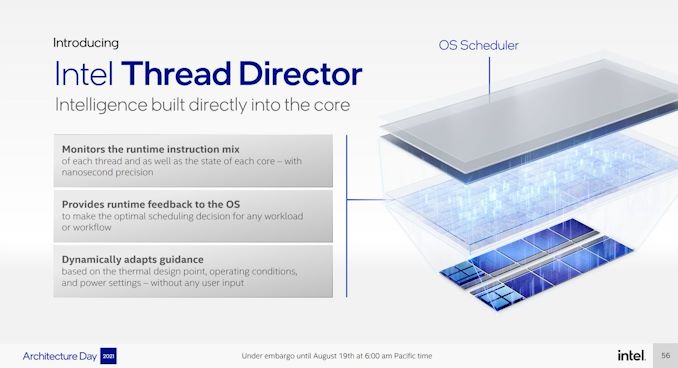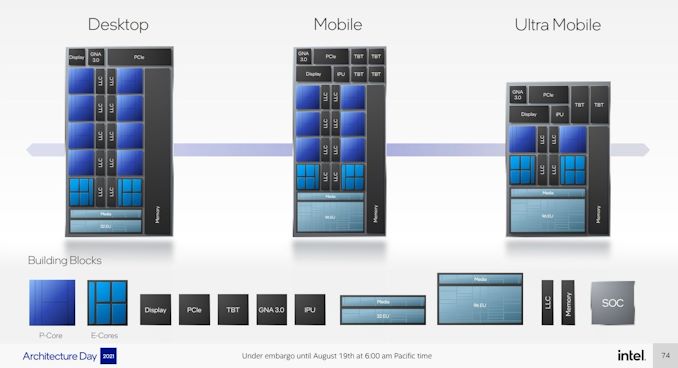Intel Architecture Day 2021: Alder Lake, Golden Cove, and Gracemont Detailed
by Dr. Ian Cutress & Andrei Frumusanu on August 19, 2021 9:00 AM ESTConclusions
Alder Lake is set to come to market for both desktop and mobile, and we’re expecting the desktop hardware to start to appear by the end of the year – perhaps a little later for the rest of the family, but all-in-all we expect Intel is experiencing some serious squeaky bum time regarding how all the pieces will fit in place at that launch. The two main critical factors are operating systems and memory.
Because Alder Lake is Intel’s first full-stack attempt to commercialize a hybrid design, it has had to work closely with Microsoft to enable all the features it needs to make managing a hybrid core design properly beneficial to users. Intel’s new Thread Director Technology couples an integrated microcontroller per P-core and a new API for Windows 11 such that the scheduler in the operating system can take hints about the workflow on the core at a super fine granularity – every 30 microseconds or so. With information about what each thread is doing (from heavy AVX2 down to spin lock idling), the OS can react when a new thread needs performance, and choose which threads need to be relegated down to the E-core or as a hyperthread (which is classified as slower than an E-core).
When I first learned Alder Lake was going to be a hybrid design, I was perhaps one of the most skeptical users about how it was going to work, especially with some of the limits of Windows 10. At this point today however, with the explanations I have from Intel, I’m more confident than not that they’ve done it right. Some side off-the-record conversations I have had have only bolstered the idea that Microsoft has done everything Intel has asked, and users will need Windows 11 to get that benefit. Windows 10 still has some Hardware Guided Scheduling, but it’s akin to only knowing half the story. The only question is whether Windows 11 will be fully ready by the time Alder Lake comes to market.
For memory, as a core design, Alder Lake will have support for DDR4 and DDR5, however only one can be used at any given time. Systems will have to be designed for one or the other – Intel will state that by offering both, OEMs will have the opportunity to use the right memory at the right time for the right cost, however the push to full DDR5 would simplify the platform a lot more. We’re starting to see DDR5 come to the consumer market, but not in any volume that makes any consumer sense – market research firms expect the market to be 10% DDR5 by the end of 2022, which means that consumers might have to be stay with DDR4 for a while, and vendors will have to choose whether to bundle DDR5 with their systems. Either way, there’s no easy answer to the question ‘what memory should I use with Alder Lake’.
Through The Cores and The Atoms
From a design perspective, both the P-core and E-core are showcasing substantial improvements to their designs compared to previous generations.
The new Golden Cove core has upgraded the front-end decoder, which has been a sticking point for analysis of previous Cove and Lake cores. The exact details of how they operate are still being kept under wraps, but having a 6-wide variable length decoder is going to be an interesting talking point against 8-wide fixed-length decoders in the market and which one is better. The Golden Cove core also has very solid IPC figure gains, Intel saying 19%, although the fact there are some regressions is interesting. Intel did compare Golden Cove to Cypress Cove, the backported desktop core, rather than Willow Cove, the Tiger Lake core, which would have been a more apt comparison given that our testing shows Willow Cove slightly ahead. But still, around 19% is a good figure. Andrei highlights in his analysis that the move from a 10-wide to a 12-wide disaggregated execution back-end should be a good part of that performance, and that most core designs that go down this route end up being good.
However, for Gracemont, Intel has taken that concept to the extreme. Having 17 execution ports allows Intel to clock-gate each port when not in use, and even when you couple that with a smaller 5-wide allocation dispatch and 8-wide retire, it means that without specific code to keep all 17 ports fed, a good number are likely to be disabled, saving power. The performance numbers Intel provided were somewhat insane for Gracemont, suggesting +8% performance over Skylake at peak power, or a variety of 40% ST perf/power or 80% MT perf/power against Skylake. If Gracemont is truly a Skylake-beating architecture, then where have you been! I’m advocating for a 64-core HEDT chip tomorrow.
One harsh criticism Intel is going to get back is dropping AVX-512 for this generation. For the talk we had about ‘no transistor left behind’, Alder Lake dropped it hard. That’s nothing to say if the functionality will come back later, but if rumors are believed and Zen 4 has some AVX-512 support, we might be in a situation where the only latest consumer hardware on the market supporting AVX-512 is from AMD. That would be a turn-up. But AMD’s support is just a rumor, and really if Intel wants to push AVX-512 again, it will have a Sisyphean task to convince everyone it’s what the industry needs.
Where We Go From Here
There are still some unanswered questions as to the Alder Lake design, and stuff that we will test when we get the hardware in hand. Intel has an event planned for the end of October called the Intel InnovatiON event (part of the ON series), which would be the right time to introduce Alder Lake as a product to the world. Exactly when it comes to retail will be a different question, but as long as Intel executes this year on the technology, it should make for an interesting competition with the rest of the market.












223 Comments
View All Comments
blanarahul - Thursday, August 19, 2021 - link
That’s Intel Thread Director. Not Intel Threat Detector, which is what I keep calling it all day, or Intel Threadripper, which I have also heard.never thought my nerdy interest would make me laugh
Hifihedgehog - Thursday, August 19, 2021 - link
One takeaway as far as the rumors we have been operating on are concerned is that Raichu (who has a 90% accuracy rating for his rumors/leaks) would now appear to have been wrong with his recent leak. Sad panda face, I know. I did some analysis elsewhere and here is what I had shared:===
The information released from Intel seems to invalidate this previous rumor above that I shared some weeks ago.
The Core i9 11900K operates at a 5.3 GHz single-core boost and gets a score of 623 in Cinebench R20.
Intel claims a 19% IPC with Golden Cove over Cypress Lake (i.e. Rocket Lake's core microarchitecture). If we see the same single-core boost clock speeds of 5.3 GHz, that would equate to 741. Let's take a huge moment to stare at this astounding achievement. This is nothing to be sneezed at! This puts AMD in a very distant position as far as single-threaded performance is concerned and puts the onus on them to deliver a similar gain with Zen 4. However, switching hats from performance analyst to fact checker, this is in no wise close to the ">810" claim as stated above. To achieve a score of >810, they would need a clock speed of roughly 5.8 GHz (623 points * 1.19 IPC improvement / 5.3 GHz * 5.8 GHz). That, quite frankly, I highly doubt.
===
Link:
http://forum.tabletpcreview.com/threads/intel-news...
That said, though, getting roughly 2/3s of the way there to the rumored performance is still a colossal jump for Intel and is minimally going to have AMD in a rather painful position until Zen 4 comes around.
arayoflight - Thursday, August 19, 2021 - link
The IPC improvement won't be the same as you can see clearly in the intel provided chart. Some workloads will run slower than Cypress cove and some can go as high as 60%.The 19% is an average, indicative figure and is not going to be the same in every benchmark. The >810 might as well be true.
Wrs - Thursday, August 19, 2021 - link
The 19% is a median figure. Based on the graphic from Intel, there are tasks that go over 50% faster and tasks that do about the same if not slower than Cypress Cove. How do we know for certain Cinebench is anywhere close to the median?mattbe - Thursday, August 19, 2021 - link
Where did you see median?/ It says right on the graph that the 19% is a geometric mean.mode_13h - Friday, August 20, 2021 - link
Aside from that, the same point applies. We don't know where Cinebench sits, in the range.Hifihedgehog - Friday, August 20, 2021 - link
As a very standard rule, though, Cinebench (especially the latest R20 and R23 iterations) have tracked very closely to the mean IPC scores that Intel and AMD have advertised for the last few years.mode_13h - Saturday, August 21, 2021 - link
Does R20 use AVX-512, though?Spunjji - Monday, August 23, 2021 - link
@mode_13h: Yes, Cinebench R20 makes use of AVX-512. It's why some of the more AMD-flavoured commentators around the interwebs insisted that R15 was the /correct/ Cinebench to use for comparisons.Personally I think it was a good example of the AVX-512 benefit in the "real world", i.e. it's there but not as substantial as Intel's pet benchmarks imply.
That aside, the lack of AVX-512 on ADL is another data point that suggests Raichu's R20 leak may have been highly optimistic. I always though it sounded a bit much.
mode_13h - Tuesday, August 24, 2021 - link
> Yes, Cinebench R20 makes use of AVX-512.Good to know. Thanks, as always!